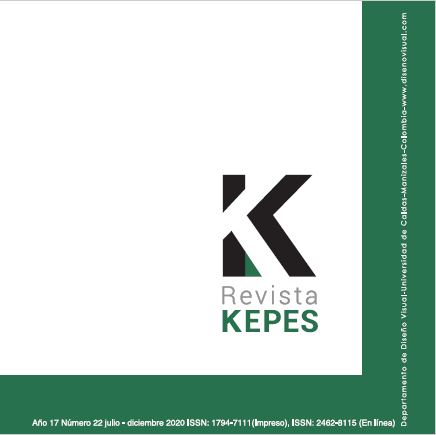Authors
Abstract
This article is derived from the educational research, The Urban Social Image, Public Space and Citizenship whose unit of analysis is Calle de la Esponsión —Carrera 23— in Manizales. It interprets the social and institutional meanings of the use of public space based on a dialogical relationship with social actors in order to recognize their daily practices, conflicts and tensions, forms of intervention and social appropriation, their rationalities and meanings of the common use of public space as a scene of social and spatial integration of cities (inhabitants and visitors). The problem idea arises from the interest in deepening the enunciated category, without meaning with this claim that the proposed social inquiry has priority over the urban-physical-spatial characteristics of the city, but rather to demonstrate the importance of the complementation of these fields for the formulation of special plans for the design of public policy that lead to significant actions that claim the street as a public space for social relations and interaction between different groups. The method is qualitative because it allows the understanding of the meanings of the individual and collective interactions of the social and institutional actors and they are represented as essential human processes. The actors are thoughtful, with sufficient capacity to perceive the world. The method is interpretive, characteristic of the original environments and its analysis is inductive. Result: The social meanings about the urban downtown of the city of Manizales express particular forms of identity such as economic informality. It is a space of resistance that the subjects construct in their own situations of domination and social exclusion in a permanent search for survival, especially when the intention is the affirmation and defense of an urban space that has been denied to them. From the institutional/instituted, a culture of rights has not yet been generated in public decision-making in the aforementioned municipality, without citizen opportunities to access the debate scenarios on city issues that constitute issues of collective interest par excellence. Conclusion: The social design approach for the formulation of public policies for public space, that allow overcoming the tensions generated by the use of that space and that can directly or indirectly affect the vision that citizens have of the social image of the city, is proposed.
References
Aguilar A. y Lima F. (2009). ¿Qué son y para qué sirven las Políticas Públicas?, en Contribuciones a las Ciencias Sociales. www.eumed.net/rev/cccss/05/aalf.htm
Bernal, M. y Mensa, A. (2009). Algunas reflexiones sobre ciudad, espacio público y ciudadanía. Revista provincia (29), 41-65. http://www.saber.ula.ve/bitstream/handle/123456789/29784/articulo2.pdf?sequence=1&isAllowed=y
Blumer, H. (1982). EI interaccionismo simbólico: Perspectiva y método. Barcelona: Editorial Hora S. A.
Borja, J. (2001). El espacio público. Barcelona: Electa Grupo Editorial.
Borja, J. (2003). La ciudad conquistada. Madrid: Alianza Editorial S. A.
Borja, J. (2014). Ciudad, urbanismo y clases sociales. Papeles de relaciones ecosociales y cambio global, 126, 111-127. https://www.jordiborja.cat/ciudad-urbanismo-y-clases-sociales/
Bourdieu, P. (1996). Raisons pratiques. París: Seuil, coll. Points.
Cardona, B. M. (2008). Espacios de ciudad y estilos de vida. El espacio público y sus apropiaciones. Revista Educación Física y Deporte, n. 27–2, 39-47, Universidad de Antioquia. https://revistas.udea.edu.co/index.php/educacionfisicaydeporte/article/view/2246
Delgado, M. (1999). Ciudad líquida, ciudad interrumpida: La urbs contra la polis. Medellín: Universidad de Antioquia.
Delgado, M. (2008). El Animal Público. (5a ed.). Barcelona: Editorial Anagrama.
Foucault, M. (2001). Defender la sociedad. Buenos Aires: Fondo de Cultura Económica.
Gómez, A. (2010). El paisaje como patrimonio cultural, ambiental y productivo Análisis e intervención para su sostenibilidad. Revista KEPES, 7(6), 91-106. http://vip.ucaldas.edu.co/kepes/downloads/Revista6_6.pdf
Gómez, Y. N. (2012). Diseño, responsabilidad social y desarrollo local. Revista Creatividad y Sociedad, 22, 1-21. https://www.researchgate.net/profile/Yaffa_Gomez_Barrera/publication/340619016_Diseno_responsabilidad_social_y_desarrollo_local/links/5e95339b92851c2f529f441a/Disenoresponsabilidad-social-y-desarrollo-local.pdf
Hernández-Pulgarín, G. (2018). Crear y conjurar la crisis de la ciudad. Diseño urbano e imagen de la ciudad en Montpellier, Francia. Revista KEPES, 15(18), 249-277. DOI: 10.17151/kepes.2018.15.18.10
Lynch, K. (1998). La imagen de la ciudad. Barcelona: Editorial Gustavo Gili.
Manzini, E., & Coad, R. (2015). Design, when everybody designs: An introduction to design for social innovation. Cambridge: MIT Press
Ríos, L. D. y Arredondo, J. (2014). Prácticas sociales en el espacio público. Usos que sobrepasan las normas sociales y el diseño del espacio. URBS. Revista de Estudios Urbanos y Ciencias Sociales 2(1), 33-50. http://www2.ual.es/urbs/index.php/urbs/article/view/rios_rojas
Sachs, C. (2007). Ciudad y gestión de las transformaciones sociales. Revista Urbano, vol. 10, núm. 16, noviembre, 2007, pp. 86-96. ISSN: 0717-3997 revistaurbano@ubiobio.cl Universidad del Bío Bío Chile Universidad del Bío Bío. Concepción, Chile. https://www.redalyc.org/pdf/198/ 19801612.pdf
Silva, A. (2006). Imaginarios urbanos. Bogotá: Arango Editores Ltda.
Wagenaar, H, (2011). Meaning in Act

 pdf (Español (España))
pdf (Español (España))
 FLIP
FLIP






















